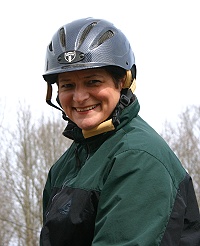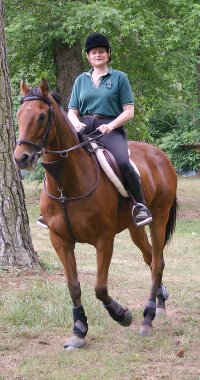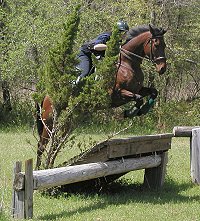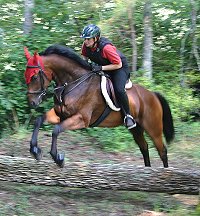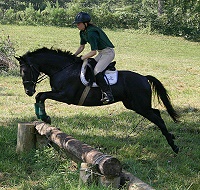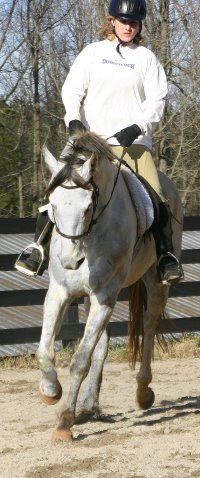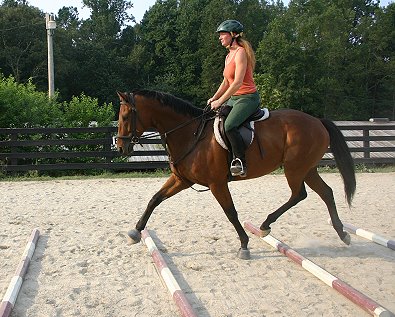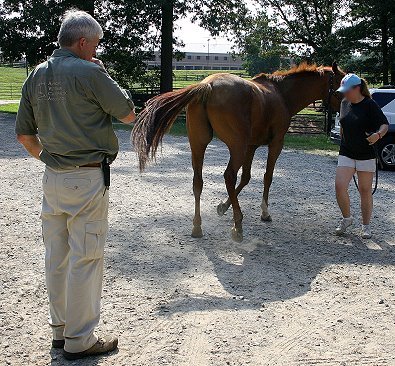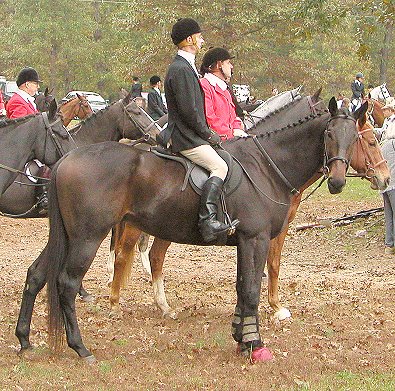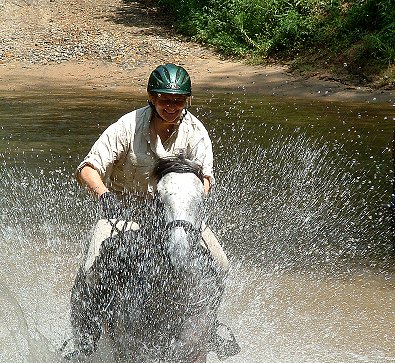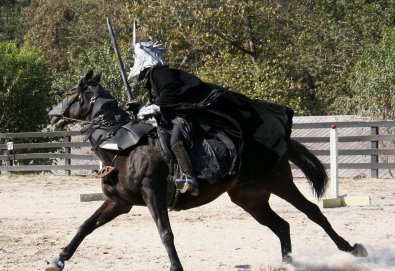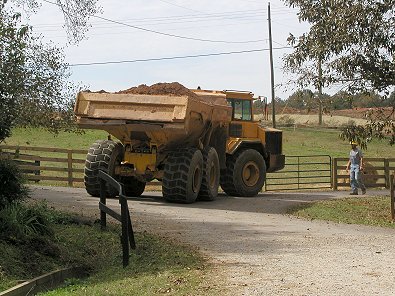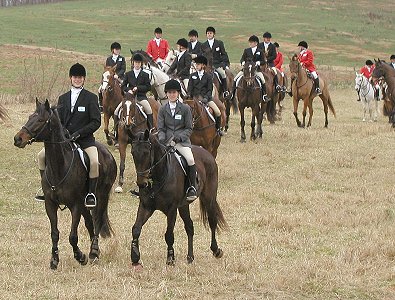Elizabeth Wood
photo by Phil West
Click here for more
TRAINING NOTES from Elizabeth
Visit our Training Notes from Elizabeth for more training tips.
Heather's Best and Elizabeth on a cross-country schooling trip.
Lord Sexton learning to jump cross-country fences.
Snowdance Kid jumping at his first "away" cross country schooling. August 2005
Charlie's first time ever cross country schooling with Marie van Roekel. August 2005
Grayboo and Paula Gunnels. February 2005
Visit our Training Notes from Elizabeth for more training tips.
Visit our Training Notes from Elizabeth for more training tips.
how we train our thoroughbreds at Bits & Bytes Farm |
Training > how we train our thoroughbredsFrom ElizabethI grew up competing at horse shows and combined training events.
Training OTTBs is extremely easy if you find ones with that have been handled well and have good attitudes. Most Thoroughbreds love to work. They love and demand attention. The more you give them, the more they want. We have never had a mean or dangerous horse at our farm. The secret to buying the right Thoroughbred is: know who you are buying from. We buy from trainers and owners that we have relationships with. They tell us the history of the horse and what kind of temperament he has. The sellers know from working with us in the past (and from reading our Success Story pages) that we make sure their horse will have a good home. The owners/trainers want to help their horses make make a smooth transition to a new career. They have spent many long hours, months or even years with this horse. They know the horse's personality and work ethic better than anyone else. They are honest with us because they know we will be a great outlet for them to move horses to when they need a stall. Most trainers do not like to send horses to auctions but sometimes it can't be helped. The trainers would much rather put their horse on our Prospect Horses page or have us buy it. They know we will buy more horses from them, if they properly represent their horses. We have many years of relationships with trainers, owners, vet and workers at tracks all over the country. We research the history of any horse we buy. Before we begin training our new off-the-track Thoroughbreds we make sure they are healthy and not hurting. Many horses are sore from racing. They get slammed in the starting gate (especially the larger ones), they twist and turn on the end of a lead line as they are being taken to the track and they buck and twist on the hot walking machines. They need chiropractic adjustments to realign their pole and pelvis. Horses coming directly from racing will be sore. But in most cases it can be easily resolved with chiropractic, good shoeing and some rest. You can get them feeling better, faster, by getting them chiropractically adjusted. We have a chiropractor who visits our farm several times a month. We have daily stretching exercises we do with the horses that the chiropractor taught us.
Thoroughbreds still racing are used to smaller, lighter saddles than we use. Their riders are lighter and smaller than the average pleasure rider. Ignorant buyers of OTTBs wonder why a horse acts up when they throw a heavy saddle and rider on the horse and crank him into a frame and do sitting trots on his sore back!!! They need time to heal and they need to learn to work off your seat. Our horses will come down to a walk from a canter with just a few half halts and light rein pressure. We ride all of them in simple snaffles, full cheek snaffles, French link or happy mouths snaffles - even fox hunting! You need to understand the Thoroughbred's past training experiences. . .The horse is in the starting gate and the jockey takes hold. They break from the gate and the horse leans into the bit and allows the the jockey to control him. Horses that do not allow the jockey to control them, do not last as race horses. They would burn themselves out before the race is over. So, contrary to popular belief, the horse is not trying to run away, he is listening to the rider. They have been TAUGHT to take contact and wait for the signal to really move out. When the jockey crosses the finish line, he/she loosens or drops the reins and sits up. Kind of like our half halt. Every Thoroughbred we have had at our farm responds to the rider's seat position. The biggest problem we have had, is, hunter/jumper riders leaning too far forward and grabbing the horse as he goes into a canter. This is the "GO" signal. Dressage riders seem to have a better understanding of their seat and hands and we have had no problems with horses getting quick with them. Never give an OTTB something to lean into. Keep your hands soft and alternate closing hands. The Thoroughbreds respond to your posting as well. The faster you post, the faster they trot. Just slow down your posting and the horse will match your speed -- right off-the-track! Now bending to the right . . . takes a little more training.
My husband, Barry Zuber, and I start the horses in the arena doing basic dressage exercises. They learn to bend and relax and to be light in your hands. They learn walk, trot and canter and how to transition between the gaits. Many of these horses know nothing but racing and need to learn how to be mounted from the ground --instead of having the rider flung onto their backs as they are jigging to the track. They need to learn to balance themselves on uneven ground and how to cross water -- this is the difficult one! Horses right off-the-track are usually weak behind. They pull with their shoulders so they do not have the proper muscles in the rear for what we want them to do. Young horses often clip their heels because of this. The muscles get built doing slow hill work and lunging in the arena.
Next we start working the horses in the woods, on and off trails and over natural obstacles. In the beginning, just stepping over a simple little log can be a terrifying task. Soon they are enjoying the trails and woods of Bits & Bytes Farm.
As they gain confidence they begin gymnastic work in the arena. The Thoroughbreds learn first to step over ground rails and then to canter over them. They jump combinations of cross rails and move on to vertical fences and coops-starting at the trot and working up to the canter. We then take them to other trails, hunter paces, fox hunts and cross country schooling courses.
Some of our horses have been fox hunted or have been taken to clinics, cross-country schooling, poker rides, hunter paces, horse shows and events. Our Dobermans, Wizard,Zulu and Sydney, do fox hound training by running up behind them, rustling leaves and jumping out from behind bushes. The cats practice running up trees in the dark shadows outside the arena just to keep the horses alert.
We have been living in the middle of a construction zone while two schools are being built around us. One is literally 50 feet off the property line and just 60 feet from our main arena. The horses are not bothered by bulldozers, dump trucks, flapping plastic, men on roofs and falling debris. These horses are not spooky or silly. They have good mouths and are ridden in a snaffle bit -- even fox hunting.
We have taken the time to know these horses. We know what type of riding they enjoy and can share that with you. We ask that you honestly represent your knowledge and experience with us so that we can put together a good match of horse and rider. Our horses are not finished horses but are well on their way to a new career. They are not for beginners unless they are working closely with a trainer. Do you have the talent and patience and desire to help bring out their fullest potential? Call us if you do. Can we find the "perfect match" for you? Visit our Training Notes from Elizabeth for more training tips.
|
|
|
©
2007 Copyright Bits & Bytes Farm /Egeland Wood & Zuber, Inc.
|
